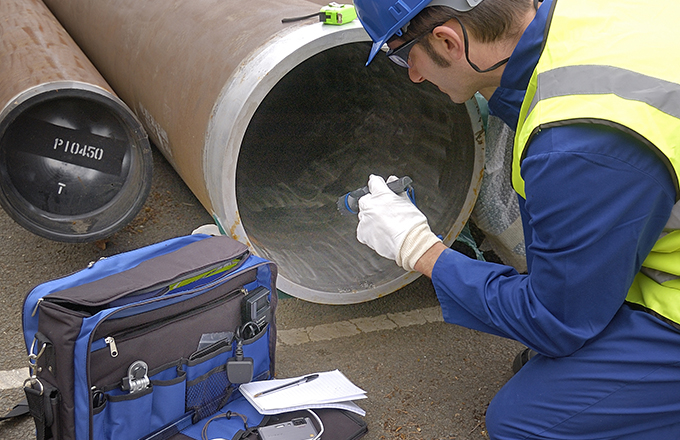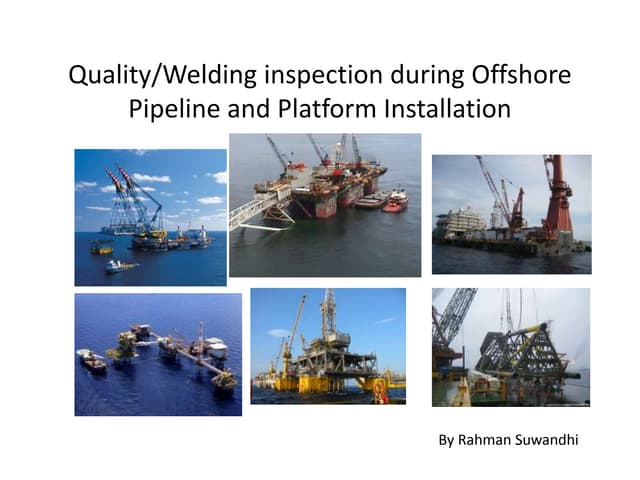Comprehensive Guide to Pipeline Welding Examination: Ensuring Honesty and Safety And Security in Pipeline Building and Upkeep
The integrity and security of pipes are critical in today's infrastructure landscape, underscoring the critical role of welding examination in pipeline building and upkeep. Pipeline Welding Inspection. The complexities involved in welding inspection raise important questions about sector standards and the advancing technologies that may redefine these techniques.

Significance of Welding Inspection
Welding evaluation plays a crucial duty in making certain the honesty and safety of pipe systems. It acts as an essential process that validates the high quality and dependability of welded joints, which are typically the most weak spots in pipeline construction. Via organized assessment, inspectors can determine potential problems such as fractures, porosity, and insufficient fusion, which might compromise the architectural integrity of the pipe.
The significance of welding examination expands past plain compliance with market requirements; it additionally safeguards public wellness and the setting. Pipes lugging harmful products posture substantial risks if failures occur. Efficient inspection methods assist prevent leaks and ruptures, alleviating ecological damage and shielding neighborhoods. In addition, comprehensive assessments can boost the durability of pipeline systems, lowering the demand for expensive fixings and downtime.
Along with making sure safety and compliance, welding examination cultivates a society of quality control within companies. By prioritizing assessment throughout the welding procedure, business can construct an online reputation for integrity and excellence, inevitably leading to enhanced client confidence and organization possibilities (Pipeline Welding Inspection). Hence, the value of welding evaluation can not be overstated in the context of pipe building and maintenance
Key Welding Processes
Different welding processes are used in pipe construction, each with its own benefits and applications. Among the most widely made use of methods are Secured Metal Arc Welding (SMAW), Gas Tungsten Arc Welding (GTAW), and Gas Steel Arc Welding (GMAW) SMAW is favored for its versatility and ability to do well in different environmental problems, making it ideal for field applications.
GTAW, frequently referred to as Tungsten Inert Gas (TIG) welding, is acknowledged for its capacity to generate high-grade welds with exceptional control over warmth input, making it perfect for thin-walled pipes and stainless-steel materials. GMAW, or Steel Inert Gas (MIG) welding, provides high deposition prices and is efficient for massive tasks, usually used in the fabrication of pipes in controlled settings.
Furthermore, Immersed Arc Welding (SAW) is used for its deep infiltration and high performance, particularly in the building and construction of large-diameter pipelines. Each of these procedures adds to the total stability and safety and security of pipe building and constructions, making it possible for welders to select one of the most ideal method based on product kind, job demands, and environmental conditions. Comprehending these key welding processes is vital for effective pipeline welding evaluation.
Usual Defects and Their Effect

Porosity, identified by little gas pockets caught within the weld, compromises the material and can cause leakages. Cracks, which may take place as a result of thermal anxieties or improper air conditioning, can propagate and result in structural failure under stress. Undercutting, where the base metal is deteriorated along the weld grain, lowers the reliable cross-section of the pipe, enhancing the threat of crack.
Incomplete combination takes place when the weld steel does not correctly bond with the base metal, leading to weak areas that may stop working under stress and anxiety. Slag addition, the entrapment of non-metallic material within the weld, can additionally weaken the joint's honesty. Recognizing and dealing with these issues early in the construction procedure is vital to making sure the long-lasting integrity and safety and security of pipeline systems, consequently securing both the environment and the infrastructure.
Examination Tools and methods

Aesthetic evaluation is the first line of defense, allowing examiners to identify surface irregularities, misalignment, or various other visible flaws. Ultrasonic testing employs high-frequency sound waves to spot interior defects, providing exact deepness dimensions and identifying defects without damaging the weld. Radiographic screening makes use of X-rays or gamma rays to create photos of the weld, allowing the recognition of internal spaces, fractures, or incorporations.
Magnetic bit screening is especially reliable for finding surface and near-surface stoppages in ferromagnetic materials. This technique includes applying a magnetic field and great iron fragments to the weld, exposing issues with the buildup of bits at flaw sites.
Along with these strategies, specialized tools such as automated ultrasonic screening tools and digital radiography systems improve assessment accuracy and efficiency, ensuring a comprehensive examination of pipeline welds during building and upkeep.
Best Practices for Compliance
Sticking to ideal techniques for compliance in pipeline welding evaluation is important for guaranteeing the stability and safety of the infrastructure. Organizations needs to develop a comprehensive top quality management system that lines up with market requirements such as ASME, API, and AWS. This includes establishing in-depth welding procedures that specify the techniques, materials, and qualifications needed for welders.
Normal training and accreditation of examination employees are vital to keep high expertise levels. Examiners should know with various non-destructive screening (NDT) techniques, consisting of ultrasonic screening, radiographic screening, and visual evaluation, to properly recognize prospective problems.
Paperwork plays a crucial duty in conformity; preserving exact documents of examinations, weld treatments, and personnel credentials aids to make certain traceability and responsibility. Arranged audits and reviews of welding techniques must be performed to identify areas for improvement and ensure adherence to developed protocols.

Final Thought
In conclusion, the implementation of strenuous welding assessment procedures is critical for making certain the integrity and safety of pipeline construction and upkeep. Constant improvement in evaluation procedures will add to the durability and reliability of pipe systems, underscoring the vital function of welding inspection in the sector.
The stability and safety and security of pipes are extremely important in today's infrastructure landscape, emphasizing the crucial function of welding evaluation in pipe building and construction and upkeep. Understanding these key welding processes is necessary for effective pipe welding examination.
Sticking to best practices for compliance in pipeline welding inspection is important for making certain the stability and safety of the facilities.In final thought, the execution of rigorous welding inspection methods is paramount for guaranteeing see this here the stability and safety of pipe building and construction and maintenance. Continuous enhancement in examination procedures his response will certainly contribute to the longevity and dependability of pipe systems, underscoring the crucial function of welding examination in the sector.